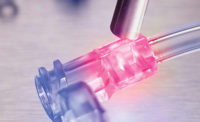Medical device manufacturers continue to consume more plastic than ever. ASSEMBLY recently asked two experts at a leading material supplier to comment on current market conditions:Glenda Eilo, global industry leader for the medical market segment at Eastman Chemical Co. (Kingsport, TN) andKenneth E. Breeding Jr., technology platform manager for the medical market segment at Eastman Chemical.
ASSEMBLY:What is the biggest trend in medical plastics today? How are you addressing it?
Eilo:The shift of healthcare away from hospitals, transitioning some care to less skilled or unskilled personnel due to the nursing shortage, and adjusting healthcare industry infrastructure to compensate for the impact of the baby boomer population as they age, are some of the trends we are currently seeing. For OEMs, optimizing costs while maintaining quality of service is a challenge in meeting these trends.
As a plastic supplier, it is important for us to help OEMs understand the plastic resins available that can ultimately enhance a product’s effectiveness and useful life. Understanding resin options ensures that the material selected is appropriate for the product’s care setting and intended use, as well as its manufacturing and sterilization processes.
Medical OEMs look for plastics that stand up in the consumer and less-skilled user environment. One of our customers, Kinetic Concepts Inc. (San Antonio), used Eastar copolyester for its innovative V.A.C. (vacuum-assisted closure) Freedom Therapy System. This lightweight, portable device allows individuals to receive needed wound care while at work or performing normal daily activities. This system is a clinically proven treatment that promotes wound healing while helping to decrease length of stay, healthcare costs, and incidence of complications for patients in acute, extended and home care settings.
Another trend is the move away from glass to plastic. For instance, frequent breakage prompted another customer, Artegraft Inc. (North Brunswick, NJ), a provider of natural collagen vascular grafts, to convert its glass culture tube to a stronger, more resilient package.
The grafts are used for hemodialysis grafts and peripheral bypasses, so it was important for the company to select a medical-grade copolyester to ensure that the product would address durability, and thus contribute to the product’s sustainability. In the end, the package was robust, stable and safe, without compromising surgical readiness or performance of the grafts. The new material also decreased secondary packaging and lowered costs for transport and warehousing.
ASSEMBLY:What types of plastics are medical device manufacturers looking for today?
Eilo:Manufacturers select material on the basis of performance potential and ease of processing. In the last few years, OEMs have sought out plastics that are robust and can be used in a variety of applications, reducing the inventory of multiple plastics. Also, sustainability has come into play.
The growing desire to embrace sustainability challenges OEMs, suppliers and other players to join together in the effort to continue to deliver exceptional healthcare products that have minimal effects on the earth. As a result, more and more product development strategies are being built around optimization of manufacturing, recycling or disposal to minimize environmental effects. Trends such as device miniaturization and the concern for producing less vaporous emissions are on the rise.
OEMs are [using] the plastics industry as a resource to learn more about alternative materials, design parts with less material, and streamline manufacturing to save energy. To this end, the industry is responding with ongoing research of biodegradable and recyclable plastics, and improving processing methods to help create industry solutions that benefit the planet.
ASSEMBLY:What is the biggest trend in adhesives used for medical device assembly?
Breeding:Of the medical device applications that I am aware of that require bonding two or more parts, the majority are being assembled by ultrasonic welding. In the case of rigid to flexible tubing, the dominant technique is solvent bonding.
Medical Plastic Trends
Looking for a reprint of this article?
From high-res PDFs to custom plaques, order your copy today!




